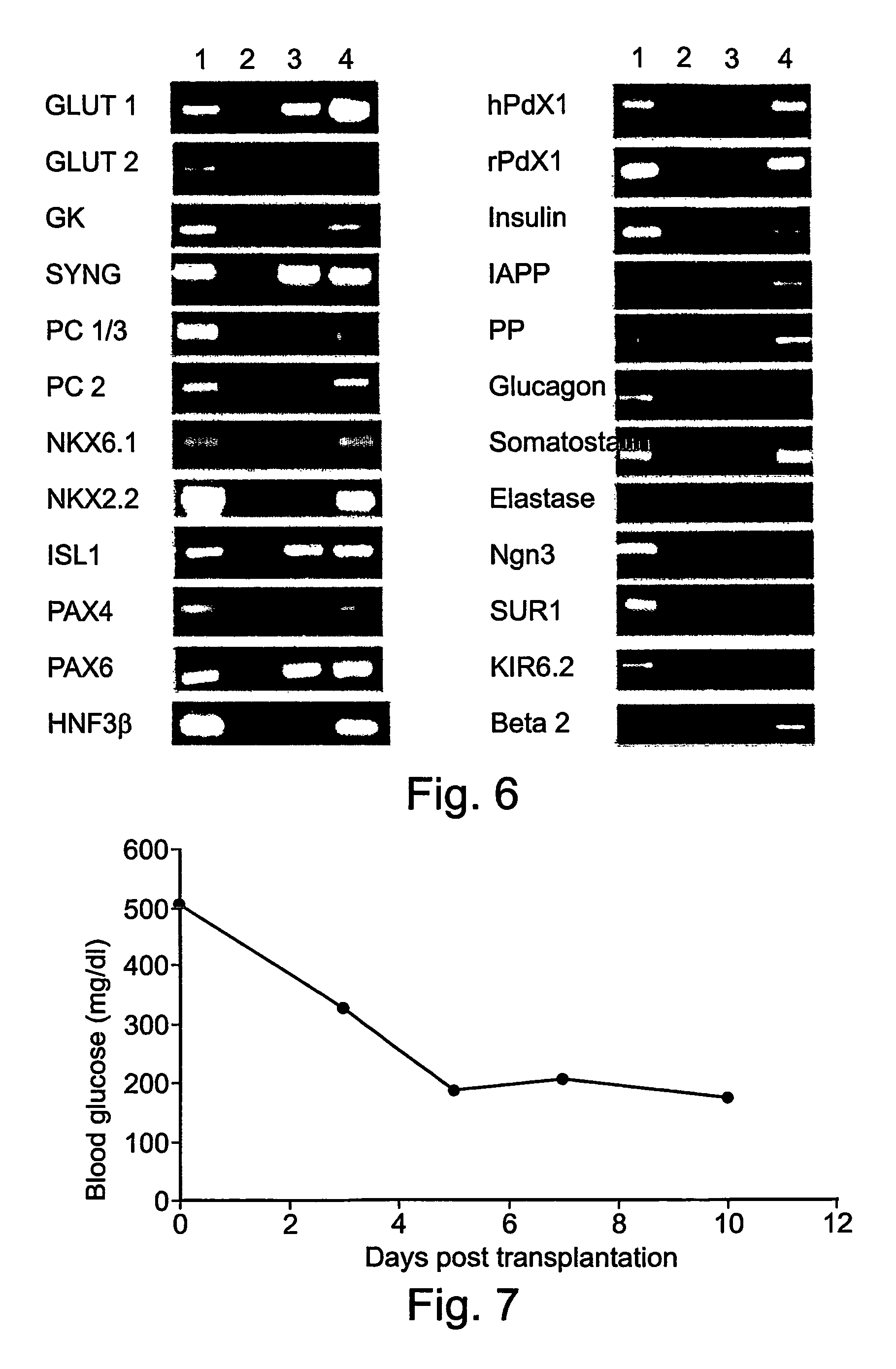Insulin-producing bone marrow derived cells and methods of generating and using same
a technology of bone marrow and derived cells, which is applied in the direction of pancreatic cells, skeletal/connective tissue cells, genetically modified cells, etc., can solve the problems of large quantities of pancreatic islets that are both difficult and expensive to isolate, and the expansion of human islets is difficult and expensive. achieve the effect of reducing blood glucose levels and reducing individual blood glucose levels
- Summary
- Abstract
- Description
- Claims
- Application Information
AI Technical Summary
Benefits of technology
Problems solved by technology
Method used
Image
Examples
example 1
Preparation of β-Like Cells Using Pdx1-Expressing Bone Marrow Stem Cells
[0141] In order to test the suitability of mesenchymal stem cells for cell replacement therapy in insulin deficient individuals, bone marrow derived cells were sequentially transfected with the hTERT—and the Pdx1-containing plasmids (SEQ ID NOs:1 and 2, respectively) to generate insulin-producing, β-like cells.
[0142] Materials and Experimental Methods
[0143] Expansion of mesenchymal stem cells from bone marrow cells—Human adult BM cells were obtained at Laniado Hospital in Israel using approved protocols. Bone marrow cells were fractionated and cultured at low density to favor the expansion of mesenchymal stem cells, essentially as described at Colter D C. et al., (Rapid expansion of recycling stem cells in cultures of plastic-adherent cells from human bone marrow. Proc Natl Acad Sci USA 97: 3213-3218, 2000). Under these conditions, the stem cell population doubling time was approximately two days.
[0144] Prep...
example 2
PDX1-Expressing Bone Marrow Stem Cells are Capable of Reducing Blood Glucose Levels In Vivo
[0160] In order to assess the capability of the Pdx1-expressing bone marrow stem cells of the present invention to reduce blood glucose levels, these cells were transplanted in a STZ-diabetic immunodeficient (NOD-scid) mouse and the glucose blood levels were determined.
[0161] Materials and Experimental Methods
[0162] Induction of hyperglycemia in NOD-scid mice—Hyperglycemia was induced in four-month-old nonobese diabetic severe combined immunodeficiency (NOD-scid) male mice (Harlan, Jerusalem, Israel) by intra peritoneal (I.P.) injections of 170 μg per gr body weight of streptozotocin (STZ). Blood glucose levels were measured in samples obtained from the tail vein using the Accutrend strips (F. Hoffman-La Roche Ltd, Basel, Switzerland). Mice were considered hyperglycemic when blood glucose levels reached 300 mg / dl.
[0163] Transplantation of Pdx1-expressing bone marrow stem cells into STZ-dia...
example 3
Inducible Expression of PDX1 in Bone Marrow Cells
[0167] To enable regulated and time-restricted expression of transcription factors inducing differentiation of stem cells into β-like cells (i.e., insulin-producing cells) various inducible DNA vectors have been constructed, as follows.
[0168] Materials and Experimental Methods
[0169] Preparation of the tet-HNF6 / Neo DNA construct—A 1.6 Kb fragment of the rat hepatocyte nuclear factor 6 (HNF6) cDNA (SEQ ID NO:51) was ligated between the EcoRb1 and HindIII restriction enzyme sites of the pUHD10-3 vector [a gift of H. Bujard, see Efrat S, 1995 (Supra)], which placed it under control of the a minimal promoter (CMV and the tet-operator sequences (tet-op) and upstream of an SV40 polyadenylation element (SV40 An). This vector also includes a neomycin resistance gene (Neo).
[0170] Preparation of the tet-NeuroD / Hyg DNA construct—A 1 kb fragment of the human neurogenic differentiation 1 (NeuroD) cDNA (SEQ ID NO:52) was ligated between the BamH...
PUM
| Property | Measurement | Unit |
|---|---|---|
| Level | aaaaa | aaaaa |
Abstract
Description
Claims
Application Information
 Login to View More
Login to View More - R&D
- Intellectual Property
- Life Sciences
- Materials
- Tech Scout
- Unparalleled Data Quality
- Higher Quality Content
- 60% Fewer Hallucinations
Browse by: Latest US Patents, China's latest patents, Technical Efficacy Thesaurus, Application Domain, Technology Topic, Popular Technical Reports.
© 2025 PatSnap. All rights reserved.Legal|Privacy policy|Modern Slavery Act Transparency Statement|Sitemap|About US| Contact US: help@patsnap.com



